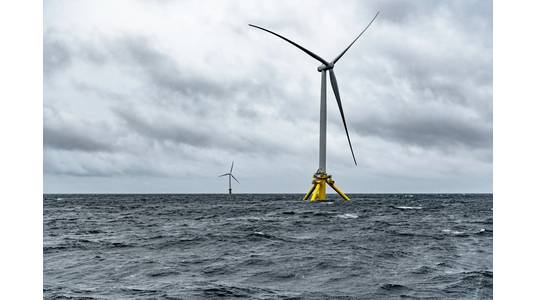
TetraSpar Demonstrator, dubbed the world’s first fully industrialized floating offshore wind foundation, has been officially commissioned and is now in operation off the coast of Norway.
The floating wind foundation, fitted with an offshore wind turbine and anchored in place at the Norwegian METCentre test site, has been successfully connected to Norway’s grid and is producing power in automatic, unattended operation. It is located next to the old Hywind demo site that has been in operation since 2009.
The TetraSpar foundation, owned by Shell, TEPCO RP, RWE, and Stiesdal, is a tubular steel structure with a suspended keel. The floating platform, including the 3.6-megawatt turbine, was towed from Denmark to the Norwegian METCentre earlier this year test site and installed in waters as deep as 200 meters.
According to RWE, the power start-up marks the start of the test phase where data on the performance and characteristics of the floating foundation will be captured and analyzed to pave the way for commercial-scale floating wind projects.
TetraSpar has an installed draught of approximately 65m and is fitted with a 3.6MW wind turbine, with a rotor size of 130m.
The developers claim that the concept offers a leaner manufacturing, assembly, and installation process with lower material costs as it allows for a fast assembly of the modules at the quayside, requiring no welding and no special port facilities.
TetraSpar can be launched using a semisubmersible barge, followed by fast turbine installation using an ordinary onshore crane.
The TetraSpar foundation concept is the modular “building block” arrangement: each foundation is assembled from tubular steel modules, most of which are common to all configurations. Manufacturing takes place in factories using industrialized methods, and their assembly near the site as well as towing are measured in days or weeks, instead of months, the companies involved have said.
Another particularity of TetraSpar Demonstrator is its stability provided by a keel deployed 50m below the floater.
Henrik Stiesdal, Chairman of the board of directors of TetraSpar Demonstrator ApS, said: “This is a huge milestone for the project. First and foremost, we are happy to have completed all phases of the project without any significant safety incidents, even though we have deployed a very innovative project with a range of world’s first elements.
"The deep experience of our project partners has been invaluable in this regard. Next, we are obviously very pleased that the new technologies, a few years ago only ambitions and design proposals, have now come to fruition. All indications are that our key target, to accelerate the industrialization of floating offshore wind, can actually be met, not only at prototype level but at large scale.”
Thomas Brostrom, Senior Vice President Renewables at Shell said: “We are extremely proud to have reached this important milestone and to have contributed to the realization of a truly innovative floating concept. Shell is committed to further develop the floating wind industry globally by providing technical and financial support to promising concepts such as Tetraspar. Ultimately, we hope to deploy floating wind technology globally and at large scale to enable further decarbonization of our customers’ activities and for society as a whole.”
Seiichi Fubasami, President of TEPCO RP, said: “There are high expectations throughout the world for floating offshore wind farms. One of the most challenging endeavors underway is the TetraSpar floating foundation demonstration project. Each stage in the process, from manufacturing and assembly, to launch and deployment, has done well, and we are very excited now to have the demonstrator in operation, thereby reaching an important milestone towards commercial operation of the TetraSpar. In Japan we expect more floating offshore wind farms to be built from 2030 and onward as we aim for realization of carbon neutrality in 2050.
The TetraSpar concept can be utilized in Japan’s natural conditions and enables the easy construction of regional supply chains thereby playing an important role as we aim to transition to renewable energies as baseload power sources. This is a promising new technology for the future and we expect the TetraSpar floater to perform well during operation off the coast of Norway over the next couple of years.”
Sven Utermöhlen, CEO Offshore Wind of RWE Renewables, said: “This project has been both challenging and inspiring. The spark of genius with the TetraSpar concept is its industrialized manufacturing and assembly methodology, which we think is crucial for long-term cost reduction. Our deep involvement in this project means we have now gathered firsthand evidence about how this approach can be scaled up to commercial projects.
"This project has taught us more crucial lessons than we could have ever expected, and it has been great to work so collaboratively with our project partners to safely deliver such an innovative technology. It has been particularly interesting to see how important it is to transfer RWE’s experience in seabed-fixed offshore wind into our floating projects. This project’s success motivates us to keep on delivering cutting-edge innovation.”



